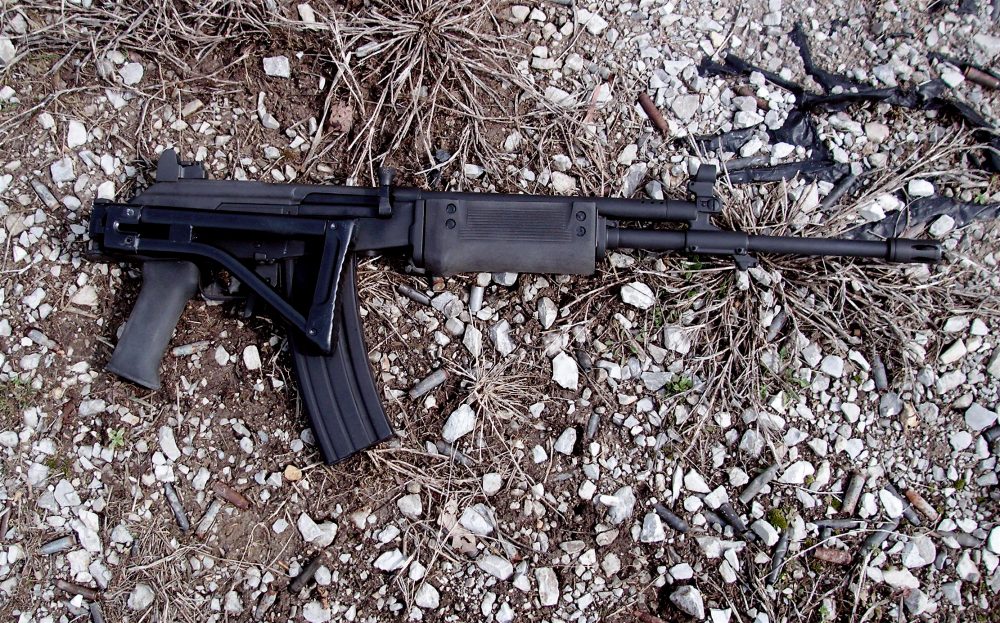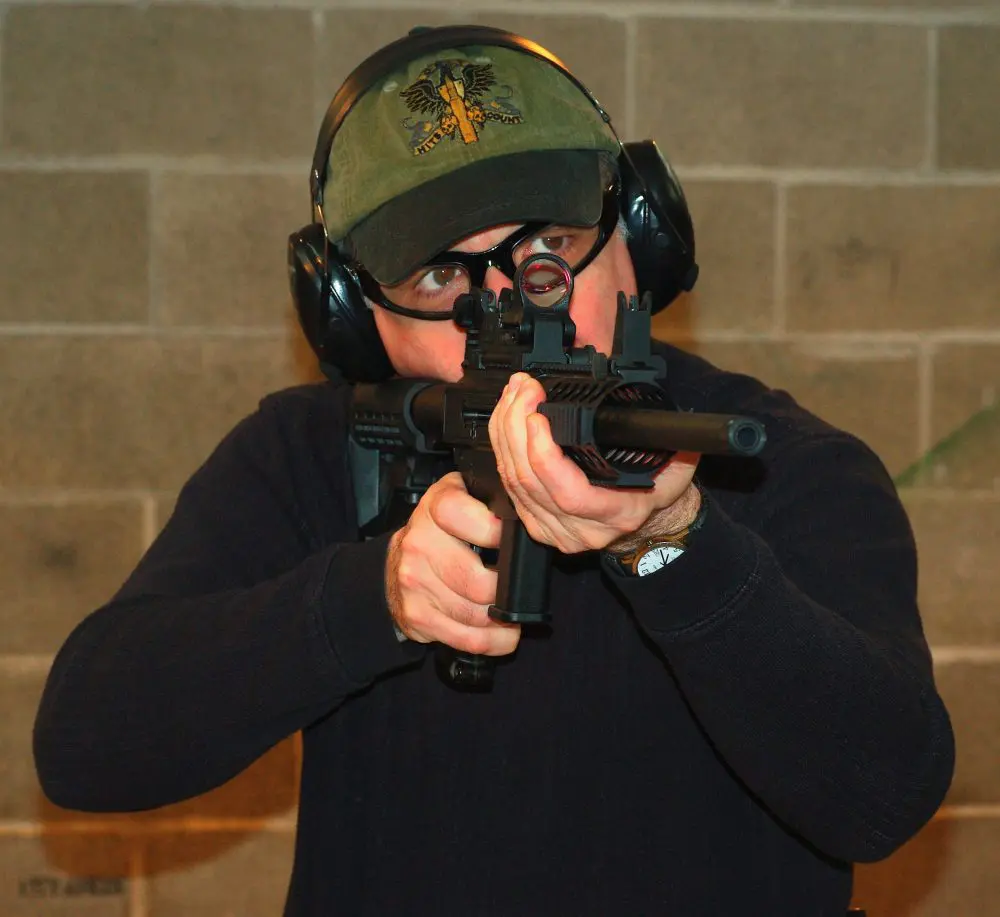I first used the Galil battle rifle more than 25 years ago when working on a security job in Africa. The model I used was the AR, which has remained my favorite over the years. I’ll discuss Galil model designations a bit later. The Galil was designed as the new rifle for the Israeli Army and was adopted in 1972. Its designers, Yisrael Galili and Yaacov Lior, basically created a product-improved AK-47. This was really quite a good choice for the Israeli Army, which was composed almost entirely of conscripts and which operated in a dusty, sandy environment. As a result, a rifle such as the Galil, which will stand up to hard usage—the AK-47’s forte—made perfect sense.
The Galil’s improvements to the Kalashnikov design are primarily ergonomic. The most obvious is the side folding stock. A lot of Israeli troops are mechanized infantry; hence they need a rifle that can be carried in confined spaces. With stock folded, the Galil is just over 29 inches. Unlike the under-folder AK stock, which is not particularly comfortable for shooting and which doesn’t pass a jump test (i.e., it makes noise), the side folder Galil stock locks up solid when folded or extended and is relatively comfortable.
Golani’s cocking handle allows ease of operation with support hand.
One of the best features of the Galil is the safety. It retains the large lever safety of the AK, a safety which must either be worked by removing the strong hand from the shooting position or by reaching under with the support hand, neither the best option for bringing the weapon into action quickly. The Galil incorporates a small selector/safety located for operation by the right thumb very conveniently. Note for anyone reading this who is familiar with the semi-auto Galils imported into the USA some years ago: on the semis, safe is back and fire is forward, while on select-fire Galils, safe is forward and fire is back.
I’ve never been particularly fond of AK sights, and the Galil addresses this deficiency as well. The front sight remains an AK-type hooded post, but the rear sight is an L flip-up with peep sights for 300 and 500 meters. The sights still aren’t great for precision shooting, but I do substantially better with them than with the AK’s rear notch. Windage and elevation are adjusted by moving the front sight up or down and right to left. An AK sight tool is needed to change elevation, while a screwdriver is necessary to change windage. On Galils, there is also a set of supplementary night sights with Tritium inserts. These front and rear sights may be folded up for night usage.
With stock folded, Golani is just a bit over 29 inches.
Another Galil feature I have found very useful is the cocking handle, which sticks up at a 90-degree angle above the receiver. This allows the support hand to be used to chamber a round without losing the shooting grip or when necessary to clear a malfunction. The Russians realize that operating the cocking handle on the AK-47/74 is enough of an issue in CQC situations that Spetsnaz I’ve worked with showed me a drill they are taught to reach under the receiver with the support hand to operate the cocking handle.
There are a few other improvements to the basic AK design, but those listed are the ones that are the most noticeable. Well, I guess the fact that the Galil is chambered for the 5.56mm round is pretty noticeable, too! As a result, the Galil has its own proprietary magazines in 35 and 50 rounds. There is also a magazine for grenade launching blanks.
The basic types of Galil that were produced are: SAR (Short Assault Rifle), MAR (Micro Assault Rifle), AR (Assault Rifle), and ARM (Assault Rifle and Machinegun). A relatively small number of semi-auto Galils were imported prior to the assault weapons ban. These came in as four variants: ARs in .223 and .308, and ARMs in .223 and .308. Prices for these rifles have risen to $2,500 or more.
Golani AR is a quick handling rifle.
As a result, I was very pleased when I saw that Century Arms had purchased a large number of Galil parts kits and was making semi-auto, civilian legal Galils—designated the “Golani.” The Golani uses U.S.-produced receivers and barrels but retains the look and feel of the Galil. Not only does the U.S.-made barrel help the Golani comply with U.S. laws, but it also has a one in nine twist as opposed to the 1:12 twist in the original Galils. As a result, either 55- or 62-grain bullets may be used with good performance.
The rifle Century seems to be producing is the .223 AR version, which I consider the best of the Galils. It is refinished and looks quite good. It retains typical Galil dimensions: 38.5 inches overall with stock deployed, 29.2 inches with stock folded, and 8.7 pounds. The night sights are present, but the Tritium inserts died some years ago and have been removed. Overall, though, the Golani is one of the “military” type rifles available for civilian sale. It comes with two 35-round magazines. Additional 35- or 50-round mags may be purchased from Century Arms at very reasonable prices.
I wanted to really test the Golani, so I loaded up the two magazines which came with the rifle, plus two other 35s and a 50 I had with my semi-auto Galil. I used surplus M193 (55-grain) ammo. My Golani fired all 190 rounds without a hitch. A couple of my friends had purchased Golanis and had a few problems when they first took them to the range, but both said the rifles shot in after a couple hundred rounds and worked smoothly henceforth.
It took me 20-25 rounds to get the Golani sighted in, but once it was on, I was shooting what I consider very good groups with the peep rear and post front sights. Groups at 100 yards were running around two inches, with the better ones around 1.5 inches, and at 200 yards were around three inches. The one group I shot at 300 yards was about 5.5 inches. Peep sights, surplus ammo, aging eyes—I was satisfied!
Golani works well with 50-round magazines, though it does not allow one to go prone.
The Golani was very comfortable to shoot and, as with every AR I’ve fired, very handy. I did quite a bit of shooting both offhand and from prone at 100-, 200-, and 300-yard plates and found it quick for moving among targets. The 35-round magazine makes it a bit difficult to go prone, but as long as the ground is relatively flat and you don’t attempt to get too low, it is possible. It took me a little while to readjust to the Golani’s safety, which is the standard military one, since I have been using my semi-auto Galil for years. I soon learned, though, to nudge the safety off with the knuckle of my thumb.
After my first shooting session with the Golani, I was so impressed that when I got home, I moved my semi-auto Galil to the back of the safe and put the Golani right up front. It will be one of my shooting rifles from now on. I’ve since taken it out a second time and remain impressed. Century International Arms has allowed American shooters to own one of the world’s premier “assault rifles” at a very reasonable price. Three cheers for Century!
SOURCE:
Century International Arms, Inc.
Dept. S.W.A.T.
430 South Congress Drive, Suite 1
Del Ray Beach, FL 33445
(800) 527-1252
www.centuryarms.com









